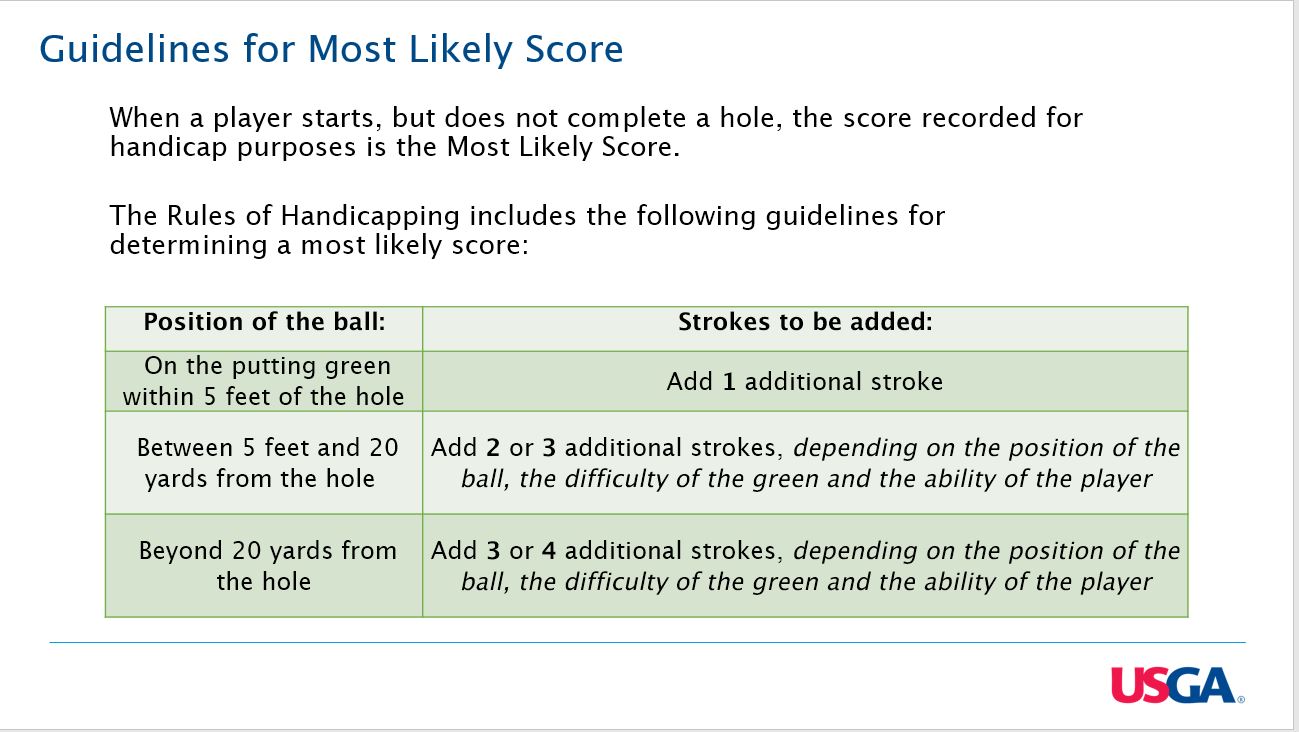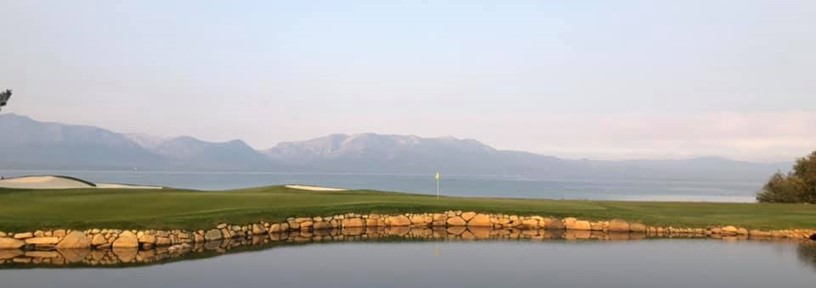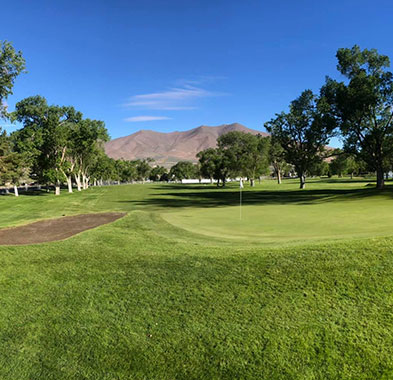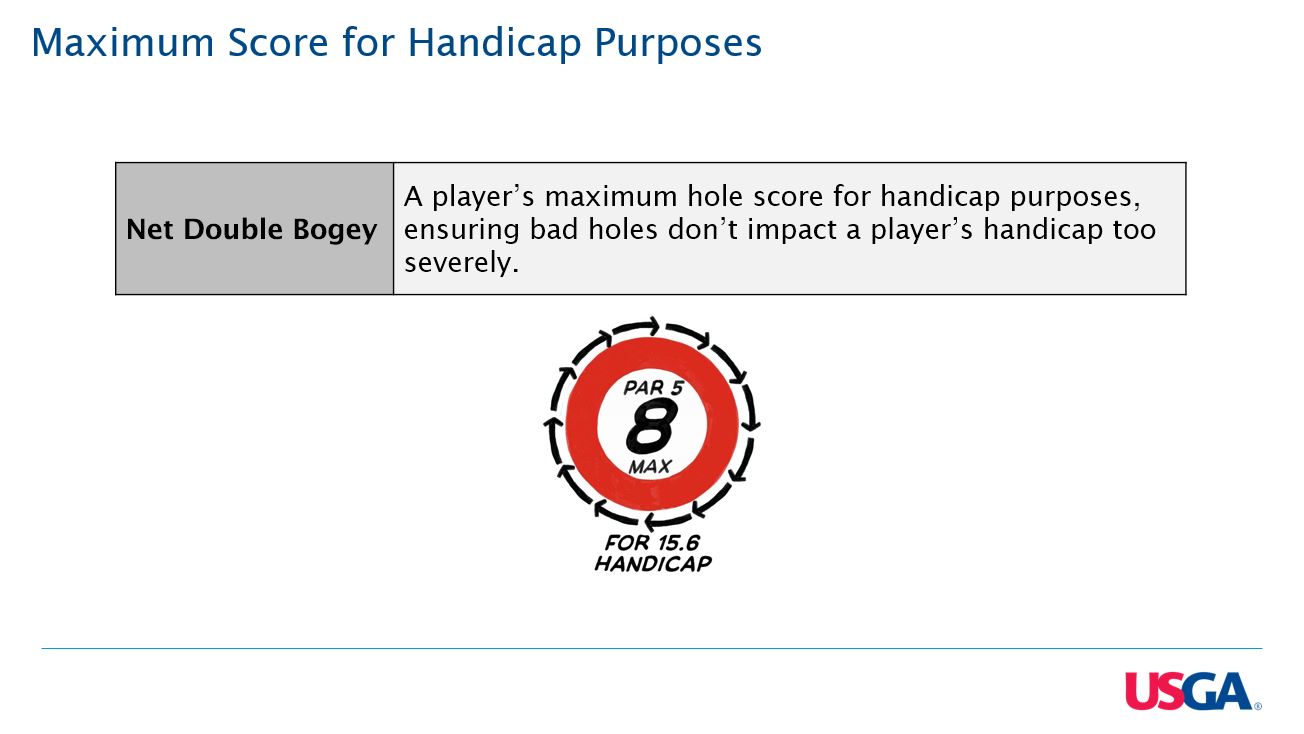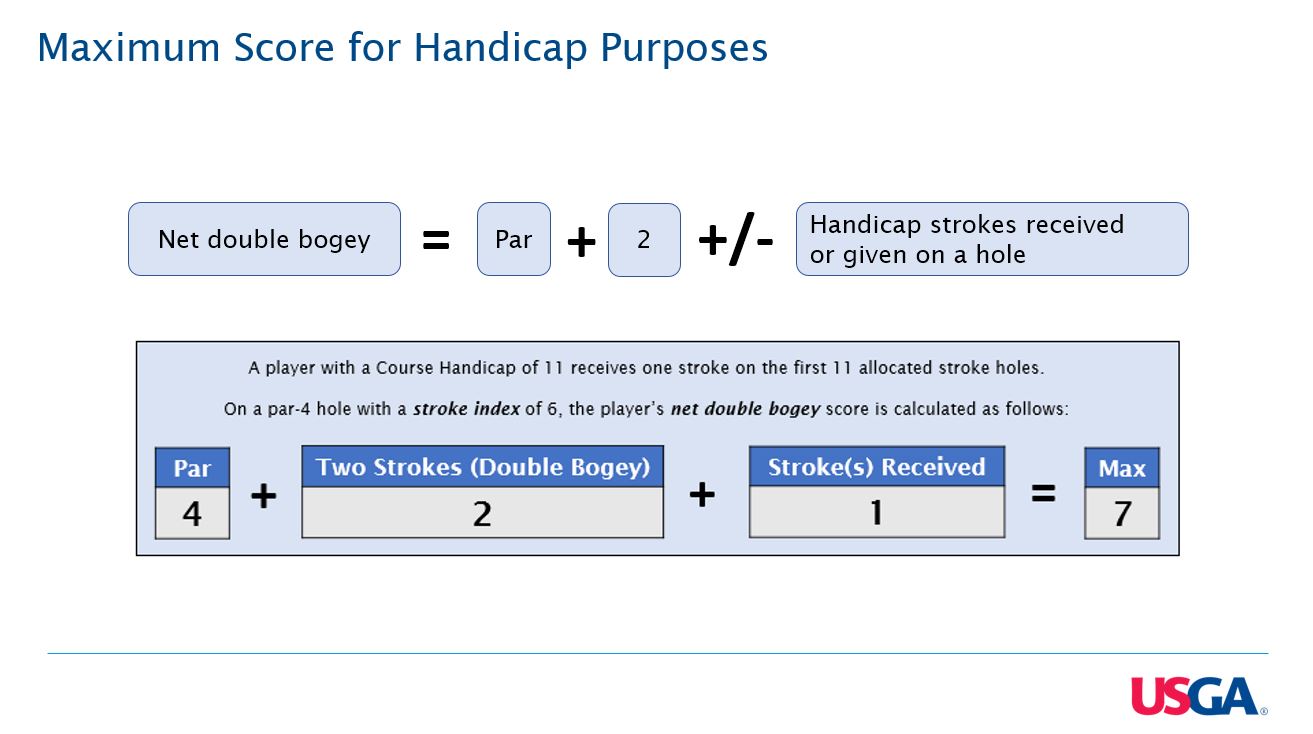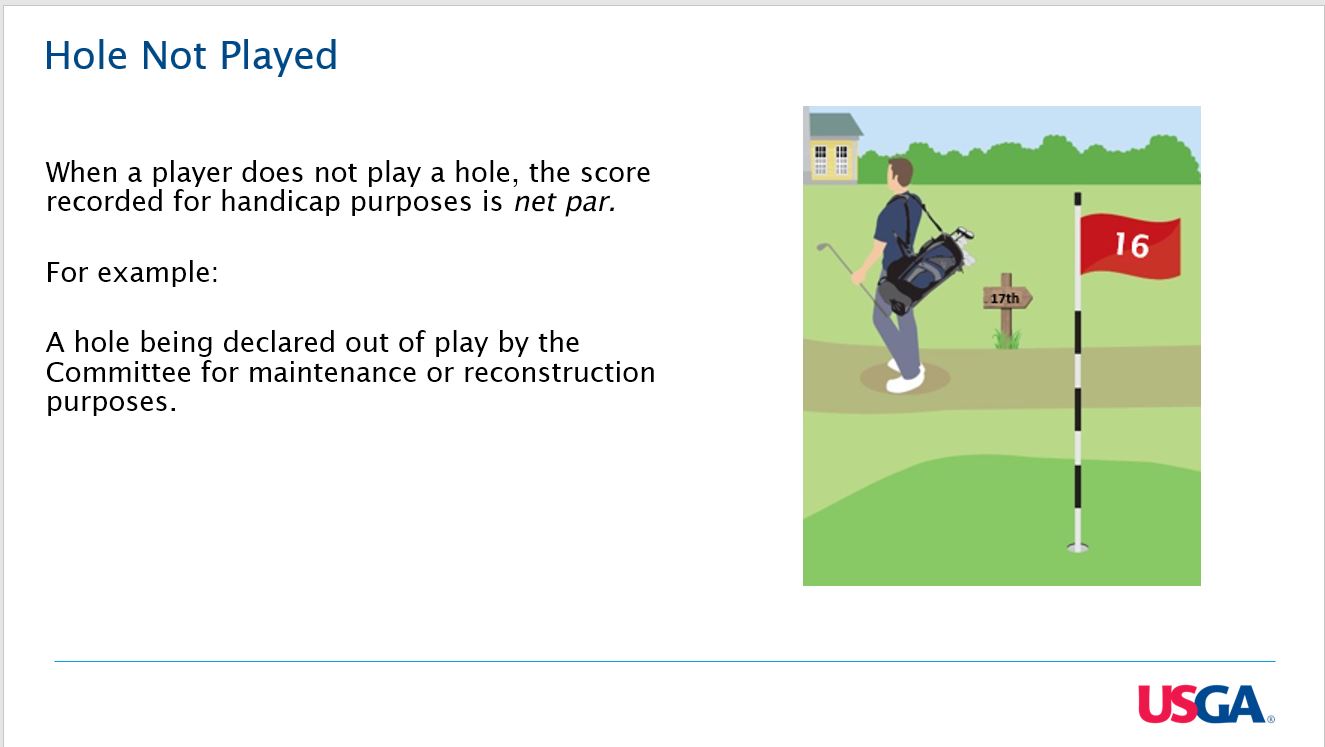USGA Virtual Rules School sign up special
Incident
On a 187-yard Par-3 hole with a water hazard in front of the green, Player A’s tee shot appears to land between the water line and the green. It was not initially visible when he arrived in the area and in searching for the ball, Player A finds a ball that is embedded just outside the margin of the water hazard. Player A removes the ball from its embedded location, cleans it and drops the ball in accordance with the relief procedure for an embedded ball and plays the ball onto the putting green. After completing the hole in two additional strokes, as Player A removes the ball from the hole and discovers it is not his original ball. Player A returns to the search area and locates the original ball in the water hazard embedded between the water line and the yellow line. When the player mistaking substituted the first ball that was not his he played from a wrong place Rule 20-7 and he incurred a penalty of two strokes. Because he has committed a serious breach he must before making a stroke on the next teeing ground, play out the hole with a second ball in accordance with the rules. In this incident, the player was required to go back to the teeing ground.
Provisional ball over a water hazard
This question comes up often. Can you play a provisional ball over a water hazard? The player is entitled to hit a provisional ball for a ball that may be lost outside a hazard[Rule 27-2a]. Players are not permitted to play a provisional for a ball that is in a water hazard. There are times when it is difficult to know if your ball is in the hazard or lost outside of the hazard. If you find the original ball outside the hazard, you must abandon the provisional and continue with your original. If you find the original ball in the hazard, or determine there is no possibility your ball could be lost outside of the hazard (short grass bordering the margin of the hazard), you must abandon the provisional and continue with the original. This could involve a trip back to the teeing ground. If you do not find the original ball and it is not virtually certain that it is in the hazard you must continue with the provisional ball. A provisional ball is an option available to the player to save time for a ball that may be lost or out of bounds. When the original ball is found the player must follow the rule for the condition the found ball presents. Example: ball in water hazard proceeds under 26 relief for a ball in a water hazard. The player is required to proceed under the applicable rule.
Rule 18-5, 20-7, exception 6-6d, and local rule with modification to Rule 6-6d
A recent ruling at a junior tournament this past week involving all these rules played out like this: Player A’s ball at rest is struck and moved by player B’s ball. All Player’s in the group believed both players should play their balls from where they came to rest. The group thought the ball is replaced only when it is on the putting green. After the round, the incident became known to the Captain of the team. Player A was informed that there was a rules infraction, playing from a wrong place (20-7) under the applicable rule, 18-5 which states “if a ball in play and at rest is moved by another ball in motion after a stroke, the moved ball must be replaced.” Consequently, not only had he played from a wrong place, a two-stroke penalty. He had also signed for a lower score. The player nor any of the fellow competitors knew a breach of Rule 18-5 had accrued. As such the Rules of Golf would assess a total of 4 penalty strokes two for playing from a wrong place and two under the exception of 6-6d: “if a competitor returns a score for any hole lower than actually taken due to failure to include one or more penalty strokes that, before returning his scorecard, he did not know he had incurred, he is not disqualified. In such circumstances, the competitor incurs the penalty prescribed by the applicable Rule and an additional penalty of two strokes for each hole at which the competitor has committed a breach of Rule 6-6d.”
[Remember Lexi Thompson] Fortunately (depending on your take) the local Rule that is a further exception to the exception in 6-6d reads like this: The Exception to Rule 6-6d is modified as follows:
Exception:
If a competitor returns a score for any hole lower than actually taken due to failure to include one or more penalty strokes that, before returning his scorecard, he did not know he had incurred, he is not disqualified.
In such circumstances, the competitor incurs the penalty prescribed by the applicable Rule, but there is no additional penalty for a breach of Rule 6-6d.
This Exception does not apply when the applicable penalty is disqualification from the competition. Example: Had the player known he had a penalty prior to returning his card and signed for a lower score than he knew he had the exception would not apply and he would be disqualified.
Teeing Ground
The “teeing ground’’ is the starting place for the hole to be played. It is a rectangular area two club-lengths in depth, the front and the sides of which are defined by the outside limits of two tee-markers. A ball is outside the teeing ground when all of it lies outside the teeing ground.
Golf Courses typically have multiple “Tee Boxes” with Tee Markers of various color. The Tee Markers define the width of the teeing ground and the depth is two club lengths in measure. When tee markers are near each other the teeing ground remains the same two-club lengths in depth from the tees you are competing from. Therefore, if there are two sets of tees near one another and you are playing from the forward tees and your two club lengths depth takes you beyond the set of tees behind you, you're still playing within the correct teeing ground.

Alternate Shot
NNGA was asked about a ruling for a local club event in which the format was alternate shot. Player A tees off, player B is not present at the starting time. Player A hits the tee shot and proceeds to hit the second shot because his partner is not present. The penalty? If Player B arrived within 5 minutes of the starting time there would be a two-stroke penalty under 6-3 and player B would have to play a shot from where player A hit the second shot. Player A would get a two-stroke penalty for playing out of turn 29-3. In this case, the team did not correct before playing from the next tee. So sorry DQ At the NIAA Boy's regionals a fellow competitor moved the flagstick while the player's ball was in motion. While the consensus in the group believed that a penalty was incured by the fellow competitor, that was not the case.
Moving Flagstick While ball Is In Motion:
Rule 24-1 specifically allows equipment of the players and the flagstick when attended, removed or held up to be moved when a ball is in motion even if doing so could influence the movement of a ball.
Other objects including loose impediments, other movable obstructions or golf balls that have not been lifted prior to the stroke may not be moved when a ball is in motion if doing so could influence the movement of a ball in motion.
Please Read Your Notice to CompetitorsThe competitive golf season has begun. Registration for 2018 NNGA events can be found at the links below: NNGA Tournaments
Women's Tournaments
With the start of the new season, I'd like to remind players of the importance of knowing the rules and more specifically the importance of reading the "Notice to Competitors." It is the committee's responsibility to provide players with conditions under which a competition is to be played (Rule 33) They include but are not limited to:
- Clarifying boundaries of the course
- Highlighting areas of ground under repair and relief procedure
- What constitutes an integral part of the course
- What to do if temporary immovable obstructions are present
- The status of roads and paths on the course
- Local rules
It is the players responsibility to know the rules (Rule 6-1) which includes the Notice to Players and outlines specific points that are particular to the course being played.
There have been some well-publicized instances of professionals failing to read the notice to competitors such as:
Ryuji Imada's 26 penalty strokes at the Mission Hills Star Trophy in China for assuming the local rule for lift clean and place gave him a one-club length distance when in fact the range was only one scorecard. Likewise, Dustin Johnson at the PGA Championship at Whistling Straits, two strokes for grounding his club in a bunker. Lexi Thompson once again the center of rule controversy this year at the Honda LPGA Thailand, was assessed a two-stroke penalty for moving a sign on her area of intended swing path which was deemed to be a temporary immovable obstruction on the "Notice to Competitors." These incidents have a common thread, failure to read the Notice to Competitors.
As we embark on our 2018 Season a gentle reminder; take the time to read the Notice to Competitors that your committee has "responsibly" provided you to save you needless penalty strokes. Knowing the Local Rules and Conditions of Competition are an essential part of playing in any competitive round of golf.
The Lexi Thompson Rule
Take a look here. A year after the memorable 4 stroke penalty that lead to a change in the rules.
The modernized rules of golf have been released. Keep in mind these rules are not in effect until January 2019
I will focus on a few of the major changes and link to the USGA for those who want to read more.
Regarding out of bounds or a lost ball. Instead of stroke and distance, a new local rule allows the option of dropping a ball incurring a two- stroke penalty. This option allows the player to drop in a large area between the point where the ball is estimated to have come to rest or gone out of bounds and the edge of the fairway that is not nearer the hole. USGA HERE
The height of the drop will be from the knee up, as opposed to two inches from the ground as initially proposed.
No longer a penalty for double hitting the ball. USGA HERE
Measuring for relief will be in club lengths not inches as initially proposed.
For more information on the modernization of the rules click here.
Don’t forget posting starts March 15th
Clarification on Local Rules: Accidental Movement of a Ball on a Putting Green and Modification of Score Card Penalty
What a local rule is. Rule 33-8 provides:
The Committee may establish Local Rules for local abnormal conditions if they are consistent with the policy set forth in Appendix 1.
A Rule of Golf must not be waived by a Local Rule. However, if the committee considers that local abnormal conditions interfere with the proper playing of the game to the extent that it is necessary to make a Local Rule that modifies the Rules of Golf, the Local Rule must be authorized by the USGA.
The Local Rule for accidently moving a ball on the putting green was introduced January 2017 and has been widely adopted by major organizations throughout the industry. It was strongly encouraged at the USGA PGA rules workshop for local clubs to adopt this rule. The committee may adopt Local Rules by referring, on a scorecard or notice board to members which Local Rules are being adopted.
This link gives a thorough explanation of accidental movement of a ball on the putting green
USGA
As of 2018 There has been a Local Rule modifying the exception to Rule 6-6d. The modification is as follows:
Exception: if a competitor returns a score for any hole lower than actually taken due to failure to include one or more penalty strokes that, before returning his score card, he did not know he had incurred, he is not disqualified. In such circumstances, the competitor incurs the penalty prescribed by the applicable Rule, but there is no additional penalty for a breach of 6-6d. The exception does not apply when the applicable penalty is disqualification from the competition.
Shared Golf Carts - Whose equipment is it?
Definition: Equipment, Note 3. When a golf cart is shared by two or more players, the car and everything in it are deemed to be the equipment of one of the players sharing the cart.If the cart is being moved by one of the players (or the partner of one of the players) sharing it the car and everything in it is deemed to be that player’s equipment. Otherwise, the cart and everything in it is deemed to be the equipment of the player sharing the cart whose ball (or whose partners ball) is involved.When a player runs over his own ball with his cart he incurs a one-stroke penalty under Rule 18-2a for moving his ball. It is a violation when your equipment causes your ball to move. When you are driving a cart, it is considered to be your equipment. If the lie is altered you would then have to place it in the nearest most similar lie within one club-length [Rule 20-3b].Note that if you or your equipment accidentally move another player’s ball while you are helping him search for it, there is no penalty and the ball must be replaced.
Arnold Palmer said, “I have a tip that can take five strokes off anyone’s golf game. It’s called an eraser.” While a good eraser might help lower your score that score will be less than par in a game that relies on the integrity of the player. There is however, a rule in golf that is nicknamed the eraser rule and can be implemented accordingly with out reservation under the rules.
20-6 Lifting ball incorrectly substitued, dropped or placed
Allows a player to correct or “erase” a ball that has been incorrectly substituted, dropped or placed in a wrong place. Many times, a player makes a mistake when getting the ball back into play, whether it is dropping in a wrong place or dropping the ball in an incorrect manner. If a player has not played a stroke at the ball that was incorrectly substituted, dropped or placed incorrectly, the Rules are going to let you erase your mistake and get it right without penalty.
Local Rules, New Video Review Protocols Introduced for 2018
Check out this video at USGA.ORG addressing a new set of video protocols for reviewing video fotoage and the adoption of a new Local Rule under
6-6d. In 2016 USGA changed the penalty for returning a wrong score for a hole due to faliure to include one or more penalty strokes, that before returning the scorcard the player didn’t know he had incurred from DQ to a 2 stroke penalty in addition to the prescribed penalty for breach of the applicable rule. The new local rule will eliminate the additional two-stroke penalty for failing to include a penalty on the score card when the player was unaware of the penalty.
Provisional Ball
a. Procedure
A provisional ball may be played if the ball may be lost outside a water hazard or is out of bounds. [Player must believe ball is outside a water hazard and possibly lost or out of bounds, Dec. 27-2a/3
A Player must announce his intention to play provisional ball to his marker or fellow-competitor in stroke play or his opponent in match play and play the provisional ball prior to he or his partner going forward to search, if not, and he plays another ball, that ball is not a provisional and becomes the ball in play under the penalty of stroke and distance, and the original ball is lost.
NOTE 1: Decision 2a/1.5 clarifies “going forward to search” means player has gone no more than a short distance to where his original ball is likely to be (approximately no more than 50 yards). This does not preclude a player from going forward to confer with a referee, retrieve a ball or a different club.
Note 2: A second provisional ball bears the same relationship to previous provisional ball
as the first provisional ball does to the original ball (see Decision 27-2a/4).
b.When a Provisional Ball Becomes the Ball in Play:
If the provisional ball is played from a place where the original ball is likely to be or nearer the hole than that place, the original ball is, by definition, lost and the provisional ball becomes the ball in play under the penalty of stroke and distance.
If the original ball is lost outside a water hazard or out of bounds, the provisional ball becomes the ball in play under the penalty of stroke and distance.
Exception: If it becomes known or virtually certain the ball not found:
The player may proceed under the applicable Rule. [Optionally, he can also proceed
with the Provisional ball under 27-2, incurring the penalty of stroke and distance.]
c. When Provisional Ball to be Abandoned
The provisional ball must be abandoned;
- If the original ball is neither lost nor out of bounds
- It is known or virtually certain the original ball is in a water hazard, Rule 26-1 applicable.
In either case further play of the provisional ball is play of a Wrong Ball, Rule 15-3.
Note: Strokes and penalty strokes made solely by play of the provisional ball subsequently abandoned are disregarded.
Winter Rules or "I Prefer a Better l Lie"
Winter Rules or preferred lies may be one of the most misunderstood and abused rules in golf. Winter rules really have nothing to do with the season of the year but rather the conditions on the course. Preferred lies is not even part of the 34 official Rules of Golf but is a local rule that individual clubs can implement at their discretion if conditions warrant, and should be withdrawn as soon as conditions improve. It can be found in Appendix 1: Part B: Section 3b. Before lifting the ball, the player must mark its position. Having lifted the ball, he must place it on a spot within an area specified by the committee ( six inches, a club length etc.), not nearer the hole than where it originally lay. While there certainly are times preferred lies has its place in the game, abusing this local rule goes against the two fundamental principals of the game: 1) Play the course as you find it; 2) Play the ball as it lies. As Richard Tufts explains in his book The Principles Behind the Rules of Golf, “Golf would cease to be a game of skill if the player were permitted to get the best of the conditions which confront him through their elimination rather than to overcome them by the expert execution of his stroke. ... The acceptance of the conditions which the player finds on the course is therefore a vital part of the game.”
Player runs over Ball at a Tournament
The Six Man Team at Red Hawk, two contestants were riding in the same cart while searching for a ball. The driver of the cart ran over the riders ball. The ruling for this instance can be found under 18-2 (ii). If the equipment of the player or his partner causes the ball to move, the player insures a penalty of one stroke. Even though the ball they were searching for was not the player driving the cart, he was still assessed a one stroke penalty. Further clarification can be found in the definition of equipment.
Note 3 which state: Note 3: When equipment is shared by two or more players, the shared equipment is deemed to be the equipment of only one of the players sharing it.
If a shared golf cart is being moved by one of the players sharing it (or his partner or either of their caddies), the cart and everything in it are deemed to be that player’s equipment. Otherwise, the cart and everything in it are deemed to be the equipment of the player sharing the cart whose ball (or whose partner’s ball) is involved.
Other shared equipment is deemed to be the equipment of the player who last used, wore, held or carried it. It remains that player's equipment until it is used, worn, held or carried by the other player (or his partner or either of their caddies). Since the player did not know the exact spot the ball was to be replaced he was required to drop the ball as near as possible to the place where it lay but not in a hazard or putting green Rule 20-3c
A couple of interesting Rulings in professional golf
Pace of play
Proposed Rule: New Rule 5.6 would encourage prompt pace of play by recommending that:
Players should recognize that their pace of play affects others and they should play promptly throughout the round (such as by preparing in advance for each stroke and moving promptly between strokes and in going to the next tee).
A player should make a stroke in no more than 40 seconds (and usually in less time) after the player is able to play without interference or distraction.
Committees should adopt a Pace of Play Policy (rather than only say they may do so).
In addition, new Rule 6.4 would expressly allow playing out of turn in match play by agreement, and for stroke play would affirmatively allow and encourage players to play out of turn in a safe and responsible way to save time or for convenience (also known as “ready golf”).
Reasons for Change:
By giving players affirmative guidance, support and encouragement on prompt play, these proposed Rule changes would help in:
- Setting expectations for both beginners and experienced players on what types of behavior are considered prompt play, including the maximum amount of time it should normally take to make a stroke, and
- Encouraging players to play faster by confirming that it is proper to play out of turn in stroke play when it is safe and responsible to do so (that is, to play “ready golf”).
- Enforcing pace of play would continue to be primarily up to each Committee, as there are limits to what the Rules themselves can do to insist that players play promptly.
These changes would enable Committees to point to specific expectations set by the Rules when using their authority to enforce prompt play, and encourage every Committee to adopt a pace of play policy so that all players on the course, whatever the type or level of play, would know what is expected of them.
There are a number of other proposed new rules that will also encourage prompt pace of play including the simplified dropping rules, allowing more areas to be marked as penalty areas, the expanded use of red penalty areas and allowing players to putt with the flagstick in the hole.
Link at USGA
Overhead Powerlines: What's the Ruling?
At the Nevada State Senior at Las Vegas National, we had a player ask the status of support wires holding up a telephone pole and then ask about the wires themselves. The telephone pole and support wires were on the course. The telephone pole and supports are immovable obstructions. Relief without penalty is given within one club length of and not nearer the hole when interference occurs with the player’s stance or the area of his intended swing. Intervention on the line of play is not, of itself, interference under this rule. Rule 24-2
As far as the overhead wires the local rule covering power lines/overhead cables was not in effect. The local rule is covered under 33-8a and Decision 33-8/13. In this case the wires would be considered an outside agency and the player would play the ball as it lies. Had the local rule been in effect the stroke would be cancelled and replayed.
Rule 3-3 Good to know
At the USGA Senior amateur qualifying round played at Red Hawk hills on August 7th a player encountered a situation where he believed he was entitled to relief because of interference with a French drain. There were no rules officials readily available. In stroke play, if a player is doubtful of his rights or the correct procedure during the play of a hole, he may, without penalty complete the hole with two balls, the original ball and a second ball proceeding in a way he feels the committee will subsequently rule was permitted under the Rules of Golf. In these circumstances, before taking further action, the player should:
- Announce to his marker, or fellow-competitor, that he intends to play two balls.
- Declare which ball he wishes to count if the rules permit
- Play out the hole with both balls recording the separate scores
Before returning his score card, the player must report the facts of the situation to the committee. If he fails to do so, He is disqualified.
The Tournament Committee will determine your score for the hole, and if the Rules of Golf allow, the score with the ball you selected will be your score for the hole.
Jon Rahm and the New Decision
For those who have been following recent Rules events in golf and were watching the Dubai Duty Free Irish Open this morning, the result of no penalty for Jon Rahm may seem very confusing. What happened was really one of the first major instances where a Committee used the “reasonable judgment” standard in the brand-new Decision 34-3/10.
On an earlier hole, Jon Rahm’s ball came to rest in a position where his ball-marker would have to be placed on top of his fellow-competitor’s ball-marker, so he marked it to the side of the ball, and then spanned the marker one putter-head to the side. When he spanned the marker back, it appeared fairly clear that he replaced the ball directly in front of his ball-marker, rather than to the side of it as he had originally. He played from the new position and therefore was potentially subject to penalty for playing from a wrong place in breach of Rule 16-1b (the Rule that allows players to mark & lift the ball on the putting green).
European Tour Rules Official Andy McFee (apologies if misspelled), pulled Rahm aside to discuss the situation with him. The details of the discussion are no public, but essentially from Rahm’s testimony, McFee determined that Rahm was aware of the awkward marking and used his best judgment to replace the ball in its original spot and was therefore no penalty was applied. Several months ago, the video evidence would have trumped this testimony, however Decision 34-3/10, introduced after the controversial Lexi Thompson situation at the ANA Inspiration, saved Rahm from penalty.
Specifically, when referring to this exact type situation the new Decision states, “A ‘reasonable judgment’ standard is applied in evaluating the player’s actions in these situations: so long as the player does what can reasonably be expected under the circumstances to make an accurate determination, the player’s reasonable judgment will be accepted even if later shown to be wrong by the use of video evidence.” [Emphasis Added]
In order to apply this standard, the Committee must take several factors into consideration to determine whether a player has done what can reasonably be expected. Two of the bullets listed in the Decision as important factors play a key role in the Rahm ruling: 1) the player’s explanation and 2) the amount by which the location was wrong in relation to the type of determination made. In this case, Rahm stated (according to sources) that he remembered he had marked the ball to the side and specifically remembered trying to get the ball back to the exact spot. While video evidence showed the spot to be probably incorrect, the amount by which it was incorrect was not significant enough to definitively say the player did not meet the reasonable judgment standard.
To make things more interesting, while Rahm was discussing this ruling with McFee, a spectator had picked up and moved his ball in play in the rough and Rahm was immediately faced with another rules situation. A referee was on site and through Rule 20-3c made sure the ball was replaced properly under the Rules (in this case by dropping).
Farb, R. (2017, July 9) Jon Rahm and new decision [Blog post] Retrieved from http://www.farbtalk.com/
Ball in motion deflected or stopped by player, partner, caddie or equipment 19-2. Standing astride or on line of putt 16-1e
At the Reno Sparks City Senior a player reached across the hole to tap in a short putt which then rolled past the hole, struck his foot and went into the hole. Is this a breach of Rule 16-1e, standing astride or on the line of putt? The answer is no. The line of putt does not extend beyond the hole. There is no penalty for making a stroke in this manner, provided the ball is fairly struck at and not raked into the hole. (Definition of "Line of Putt" and Rule 16-1e). However, the player was penalized one stoke under Rule 19-2 Ball in motion deflected or stopped by player, partner, caddie or equipment. The ball was holed.
When you must abandon your provisional ball
We’ve all been there, hit a lousy tee shot off into the desert and thinking in might be long gone, we (properly announce) and hit a provisional ball and it’s a beauty, long and right down the middle. Do you have to look for your ball? Can you just say “It’s lost”? Let’s take a look.
First off you are not required to look for your ball. However it’s not considered lost simply because you have declared it so. If anyone finds your ball before you play your provisional ball from the place where the original ball is likely to be or from a point nearer the hole than that place - and the five minute search has not expired (Decision 27-2b/1) you must abandon your provisional ball and play your original ball.
Other things to consider:
- You can not refuse to identify your ball. If someone finds what they believe to be your ball you must identify it (Decision 27/13)
- If you are virtually certain your ball is in a water hazard and you play a provisional ball from the place the original ball was last played you have not by definition played a provisional ball under Rule 27-2, rather you have proceeded under stoke and distance Rule 27-1 and you have forfeited the right to proceed under the water hazard rule (Decision 27-2a/2)
- If you play a provisional ball in the belief that your ball my be lost outside a water hazard or out of bounds and consequently discover there is no possibility of it being lost outside a water hazard but in fact it is virtually certain your ball is in the hazard you must abandon the provisional ball and proceed under Rule 26-1
Rule change eliminates 'Dustin Johnson penalty' at Erin Hills for U.S. Open
Alec Lewis and Gary D’Amato Milwaukee Journal Sentinel
Dustin Johnson won't have to worry about a penalty during the U.S. Open at Erin Hills this week like the one he incurred in the final round of the 2016 championship at Oakmont Country Club. The rule that affected Johnson and caused a controversy has since been altered. On Dec. 8, 2016 the United States Golf Association and the Royal & Ancient Golf Club enacted a local rule that eliminates penalties when the ball is accidentally moved on the putting green. It went into effect Jan 1, 2017 On the fifth hole of that Sunday round last year, Johnson's ball moved as his putter inched toward it. He immediately raised up. Did he cause the ball to move or did it move on its own? If the latter was the case, would he be charged the one-stroke penalty that Rule 18-2 then required? After conversation about the situation, referee Mark Newell instructed Johnson to play on with no penalty. But after officials watched a video review, they concluded Johnson had caused his ball to move. Six holes later, Johnson was informed that he had incurred a penalty stroke. Although he won the Open by three strokes, the moment was etched in the memories of many.
The NNGA as well as the USGA and PGA have adopted this new local rule for all compitions.
When a player’s ball lies on the putting green, there is no penalty if the ball or ball-marker is accidentally moved by the player, his partner, his opponent, or any of their caddies or equipment.
The moved ball or ball-marker must be replaced as provided in Rules 18-2, 18-3 and 20-1.
This Local Rule applies only when the player’s ball or ball-marker lies on the putting green and any movement is accidental.
Note: If it is determined that a player’s ball on the putting green was moved as a result of wind, water or some other natural cause such as the effects of gravity, the ball must be played as it lies from its new location. A ball-marker moved in such circumstances is replaced.”
A fellow competitor after three putting grabbed a club and hit his ball into the desert. Is there a penalty?
His temper will cost him two strokes in stroke play or loss of hole in match play. Per rule 7-2 a player must not make a practice stroke during the play of a hole. Between the play of holes a player must not make a practice stroke, except that he may practice putting or chipping on or near:
- a) the putting green of the hole last played,
- b) any practice putting green, or
- c) the teeing ground of the next hole to be played in the round, provided a practice stroke is not made from a hazard and does not unduly delay play under (Rule 6-7).
The committee may, in the conditions of a competition (Rule 33-1) prohibit:
- a) practice on or near the putting green of the hole last played and
- b) rolling a ball on the putting green of the hole last played.
Here is the new decision from the Lexi Thompson incident
Under the new decision, called Decision 34-3/10, those running a tournament can limit the use of video when video reveals evidence that could not reasonably be seen with the “naked eye,” and when players use their “reasonable judgment” to determine a specific location when applying the rules.
Hole closed? Temporary greens or tees in play? Now what? Answer here
Modernizing Golf's Rules Click here for link to website explaining the proposed changes.
What to do when your ball damages the hole, like Russell Henley's approach shot. Link here
New Local Rule takes effect Jan 1. (Note: this is a LOCAL rule and your club will need to adopt it first, it is not automatic.)
Link to USGA site for video and explanation. Click Here
Check out the new rule in action at the WGC Dell Match Play
Link to Video Here
